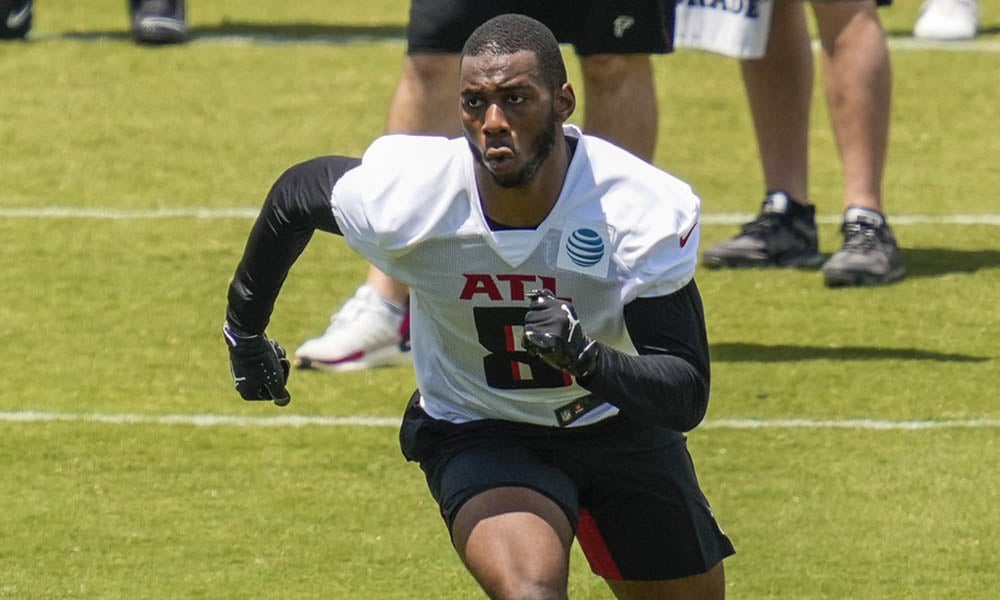The Case for Kyle Pitts as the Rookie Draft 1.01

Editor’s Note: The following article was written by Member Corner writer Pat Wright. Member Corner writers are DLF followers with an interest in developing their writing. We’re happy to allow them to hone their skills, receive exposure and interact with our community. Please be constructive with all comments.
The beautiful thing about fantasy football is that there is a wide range of views on roster building, player evaluation, scoring systems, and many other things. Some owners prefer to go ‘Zero RB’ in order to get wide receivers early and try to hit lotto tickets later in the draft. Others will go into startup drafts going running back in rounds one and two, regardless of value.
While every strategy has its pros and cons, I’m presenting to you the case for Kyle Pitts as the first pick in rookie drafts.
This strategy is applicable to almost any team in any league, and is even stronger in tight end premium leagues. A lot of the time when we are doing rookie drafts, we have strong parts of our roster, which makes us lean towards drafting another position in order to strengthen our overall roster makeup. The number one benefit of taking Pitts number one is this: the tight end position is an absolute dumpster fire at the moment.
Let’s start by looking at the top-12 scoring tight ends based on points per game with a minimum of ten games played in order to eliminate smaller sample sizes.
To no one’s surprise, Travis Kelce was number one with 20.9 PPR points per game. Kelce finished 2020 a full 3.5 points ahead of second-place Darren Waller, who finished with 17.4 PPG. George Kittle would have in all likelihood finished with the second or third most points had he been healthy all season. According to the most recent DLF ADP, Kittle is the TE1. The reason I can say he would have in all likelihood finished top three is the biggest argument for Pitts being the rookie 1.01: they’re both tight ends!
There are big question marks surrounding almost every other tight end in the top 12. Mark Andrews is riding the coattails of Lamar Jackson’s absurd 2019 season where he threw a touchdown once every 11 pass attempts, and one in every 7.5 completions went for a touchdown. Those numbers weren’t sustainable, and it showed in 2020 when Jackson threw a touchdown once every 14.5 pass attempts and on every 10.8 completions. Andrews is currently the TE3, but I do expect him to fall behind Pitts and maybe Waller when the ADP arrives.
After Andrews are TJ Hockenson, Noah Fant, and Dallas Goedert, all players you cannot trust at this point in their respective careers. If you don’t have a top-six tight end, streaming TEs and using the waiver wire is probably your best bet for production.
The discrepancy in points is another big reason that Pitts should be the 1.01. As stated above, Travis Kelce finished 2020 with 20.9 points, compared to TE12 Jonnu Smith, who averaged 9.5 points per game.
When looking at receivers, if you want to take Ja’Marr Chase at 1.01, WR1 Davante Adams led all wide receivers with 25.6 points per game, while WR12 AJ Brown had 17.7, for a difference of 7.9.
How about a running back (whoever you think is the 1.01 between Javonte Williams, Travis Etienne, and Najee Harris)? In 2020, Alvin Kamara was number one with 25.2 per game, while RB12 Josh Jacobs finished with 15.4. While this number is closer to the tight ends, mixed into the RB1s were waiver-wire pickups James Robinson and Myles Gaskin. Travis Kelce more than doubled the 12th-ranked player at his position. Having a top-tier tight end gives your dynasty team a significant competitive advantage in the majority of your matchups.
Circling back to Pitts – he is not your run-of-the-mill tight end. We have seen the hype in years past with players like Eric Ebron, Vernon Davis, OJ Howard, etc. but most of the hype with those players was based solely on athleticism and draft capital. Not only is Pitts as, or more, athletic as those aforementioned players, but he is simply a better football player. His athleticism, route running, catch radius, and ability to win at the catch point put him ahead of all of those other highly touted tight ends.
Pitts also is the highest-drafted tight end in NFL history, so he has the draft capital to go with his physical traits. Playing in a high-powered offense but with subpar defense, the Falcons should be throwing the ball a lot in 2021. Most tight ends will take two or three years to become fantasy-relevant, but with Pitts, we can expect top-six numbers right away as a rookie. No other rookie is a bigger favorite to be number one at his position in ADP this time next season than Kyle Pitts, and that’s a chance you need to take.
- The Case for Kyle Pitts as the Rookie Draft 1.01 - May 24, 2021
- Why Age Doesn’t Matter as Much as You Think - June 13, 2016


































































